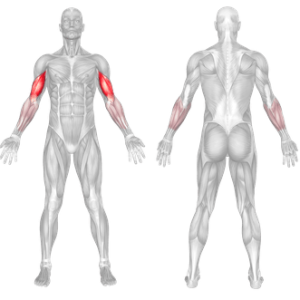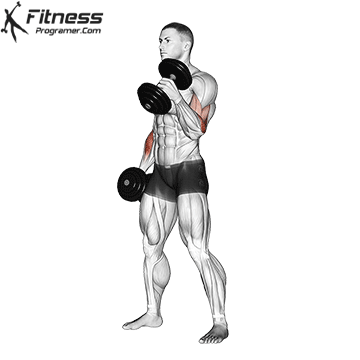Hammer Curl
Hammer Curl is a strength training exercise that primarily targets the biceps muscles in the upper arm. It is performed by holding a weight in each hand with a neutral grip, which means the palms of the hands are facing each other, and then curling the weights towards the shoulders. The neutral grip targets the brachioradialis muscle, which is located on the outer forearm and assists in flexing the elbow joint.
The hammer curl can be performed using a variety of equipment, including dumbbells, kettlebells, or resistance bands. It is a versatile exercise that can be incorporated into a workout routine to help build overall arm strength and size.
How To do:
Here are the steps to perform the alternate hammer curl:
- Stand or sit with good posture: Hold a weight in each hand with a neutral grip, palms facing each other. Your arms should be fully extended and hanging by your sides.
- Curl one arm at a time: Exhale and curl one weight towards your shoulder, while keeping the other weight extended and hanging by your side.
- Contract your biceps: At the top of the movement, squeeze your biceps to fully contract the muscles.
- Lower the weight: Inhale and slowly lower the weight back to the starting position, keeping your elbow close to your body and maintaining control throughout the movement.
- Repeat with the other arm: Repeat the movement with your other arm, curling the weight towards your shoulder while keeping the other arm extended and hanging by your side.
Alternate arms: Continue alternating arms, curling one weight at a time while keeping the other arm extended and hanging by your side.
Hammer Curl Benefits
1- Brachioradialis muscle activation: The hammer curl targets the brachioradialis muscle, which is a muscle that runs from the lower end of the humerus bone to the radius bone in the forearm. The brachioradialis is a key elbow flexor, and it plays a significant role in lifting and carrying objects. When you perform the hammer curl, the neutral grip position places a greater emphasis on the brachioradialis muscle, leading to greater activation and recruitment of this muscle.

2- Biceps muscle activation: The biceps muscle is also activated during the hammer curl, but to a lesser extent than during a traditional bicep curl. The biceps muscle runs from the shoulder to the elbow and is responsible for flexing the elbow joint and rotating the forearm. When you perform the hammer curl, the biceps muscle acts as a synergist to the brachioradialis muscle, providing additional support and assistance during the movement.
3- Forearm muscles activation: In addition to the brachioradialis and biceps muscles, the hammer curl also activates the muscles of the forearm, including the flexor carpi radialis and the extensor carpi radialis. These muscles help to stabilize the wrist and forearm during the movement, allowing for proper form and alignment.
4- Brachialis muscle activation: The brachialis muscle is a key muscle located in the upper arm that is responsible for elbow flexion. The neutral grip position places a greater emphasis on the brachioradialis muscle, but the brachialis muscle is still actively engaged to help lift the weight. The brachialis muscle activation during the hammer curl is important because it helps to develop overall upper arm strength and size, while also contributing to functional strength for activities of daily living. Incorporating a variety of exercises that target the brachialis muscle, such as the hammer curl, can also help to prevent muscle imbalances and promote overall muscle development.
Overall, the hammer curl is an effective exercise for targeting the brachioradialis muscle and the biceps muscle in the upper arm. By using a neutral grip, you can place a greater emphasis on the brachioradialis muscle while still engaging the biceps muscle and forearm muscles. With consistent practice, the hammer curl can help to improve upper arm strength and size, as well as overall functional strength for activities of daily living.
Hammer Curl Muscles Worked
The brachioradialis is the primary muscle targeted during hammer curl. The flexor carpi radialis and extensor carpi radialis act as stabilizers to keep the wrist and forearm in a neutral position during movement, while the brachialis and biceps brachii act as synergists or secondary muscles.


